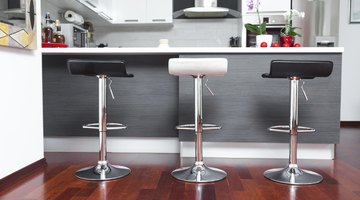DIY Baseboard Cabinet Trim
Tucked away under base cabinets, baseboard cabinet trim is not highly visible, but it covers joints, seals gaps, and adds the finishing touch to cabinets. The installation of baseboard cabinet trim is not complicated. With so many options available, anyone can find something that fits.

Toe Kicks Explained
Typical base cabinets employ a 3- by 3 1/2-inch recessed area along the front edge for your toes. Also known as a toe kick, this recess provides a comfortable place for your toes when facing or working at the counter. Baseboard trim for toe kicks should be no thicker than 1/2 to 5/8 inch, and it should be durable enough to withstand an occasional bump or kick. Even though it's not highly visible, the trim should complement the flooring and cabinets with an appropriate color or finish.
Vinyl Versatility
Even hardwood cabinets don't typically include hardwood toe kicks. Usually made with pine or poplar, toe kicks function as support only and require some type of baseboard trim to finish them off. Vinyl is widely used for baseboard or toe kick trim, since vinyl is an affordable, rugged surface that can take a beating.
Sometimes referred to as vinyl cover base, it is water-resistant and durable enough to withstand kicks, scratches, and dents. The real beauty of vinyl baseboard is its ability to conform to deviations in surfaces. It bends to fit odd shapes and uneven floor lines. Because it is typically flexible enough to bend around corners, you can use long pieces without cutting it. When you do need it cut, it's easy to trim with a utility knife. Molded corners are also available for convenience. Choose from a variety of colors to match existing designs, and install it with adhesives.
Hardwood Overlay
If you prefer the look of traditional hardwood, use hardwood overlay as baseboard trim. Cut 1/4-inch lumber or plywood, add stain and lacquer to match existing woodwork, and attach the strips directly to the toe kick with adhesives and finish nails.
If you're still in the planning stages, you can have the structural or integrated toe kick built with hardwood, and then stained and lacquered with the cabinet. Hardwood toe kicks are high-end and durable but require occasional maintenance to retain the finish. If feel that you don't need hardwood toe kicks but don't want to add an overlay, consider integrated poplar toe kicks. When stained and lacquered to match, they are hard to distinguish from hardwood and cost about half as much.
Basic Moldings
Standard baseboard trim is usually too tall to fit under cabinets. Typical door or window casing, sometimes referred to as ranch-base or colonial trim, is no thicker than 5/8 inch and is generally between 2 1/4 and 2 1/2 inches tall. The profile consists of a rounded, tapered edge from top to bottom. This type of molding is ideal for baseboard cabinet trim and is often used for efficiency and affordability.
Purchase paint-grade pine or, for a more exclusive baseboard, purchase oak or mahogany. Because standard molding is generally shorter than the toe kick, matching stain should also be applied to the existing, integrated toe kick board before installing the molding. Use a miter saw to cut the angles for corners and a brad or finish nailer to attach the molding to the toe kick. Fill the nail holes with putty crayon.
References
Resources
Writer Bio
Specializing in hardwood furniture, trim carpentry, cabinets, home improvement and architectural millwork, Wade Shaddy has worked in homebuilding since 1972. Shaddy has also worked as a newspaper reporter and writer, and as a contributing writer for Bicycling Magazine. Shaddy began publishing in various magazines in 1992, and published a novel, “Dark Canyon,” in 2008.
Photo Credits
- paulprescott72/iStock/Getty Images
- paulprescott72/iStock/Getty Images
More Articles



